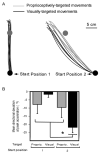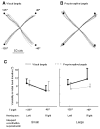The influence of target sensory modality on motor planning may reflect errors in sensori-motor transformations
- PMID: 19647787
- PMCID: PMC2765049
- DOI: 10.1016/j.neuroscience.2009.07.057
The influence of target sensory modality on motor planning may reflect errors in sensori-motor transformations
Abstract
Multi-sensory integration studies have shown that combining heterogeneous signals can optimize motor performance by reducing errors inherent to any single modality. However, it has also been suggested that errors could arise from erroneous transformations between heterogeneous coordinate systems. Here we investigated the effect of visuo-proprioceptive integration on the control of multi-joint arm movements by manipulating target modality. When the target was visual, movement control required the integration of visual target signals with proprioceptive signals about limb configuration. In contrast, when the target was the unseen fingertip, movement control relied solely on proprioceptive signals since visual feedback of hand position was precluded. We hypothesized that a faulty integration of visual target signals with proprioceptive arm signals would result in a less accurate planning of visually-targeted movements with respect to proprioceptively-targeted movements. Different inter-joint coordinations patterns were tested by varying starting hand position. Results showed larger initial trajectory deviations from target direction for visually-targeted movements involving substantial shoulder and elbow motions. Inverse dynamic analysis revealed that these deviations were associated with less efficient intersegmental coordination. The control of visually-targeted movements thus appeared sub-optimal compared to proprioceptively-targeted movements when considering theoretical models of motor planning assuming kinematic or dynamic optimizations. Additional experiments further highlighted the effect of target position, and visual feedback of starting hand position, on motor planning for proprioceptively- and visually-targeted movements. Our findings suggest that the integration of heterogeneous sensory signals related to hand and target positions introduces errors in motor planning.
Figures






References
-
- Adamovich SV, Berkinblit MB, Fookson O, Poizner H. Pointing in 3D space to remembered targets. I. Kinesthetic versus visual target presentation. J Neurophysiol. 1998;79:2833–2846. - PubMed
-
- Andersen RA, Snyder LH, Bradley DC, Xing J. Multimodal representation of space in the posterior parietal cortex and its use in planning movements. Annual Rev Neurosci. 1997;20:303–330. - PubMed
-
- Baud-Bovy G, Viviani P. Amplitude and direction errors in kinesthetic pointing. Exp Brain Res. 2004;157:197–214. - PubMed
Publication types
MeSH terms
Grants and funding
LinkOut - more resources
Full Text Sources
Medical

